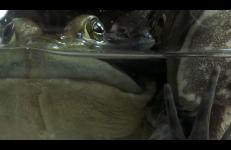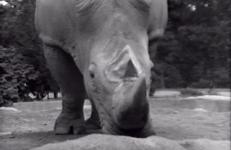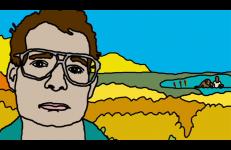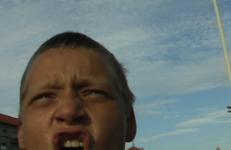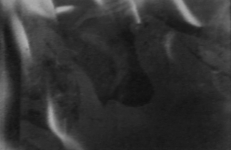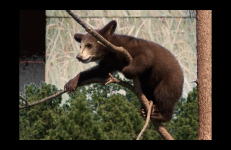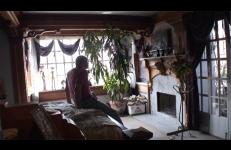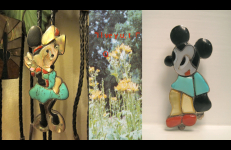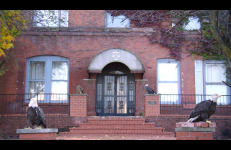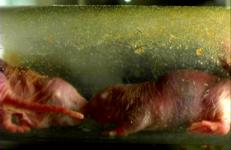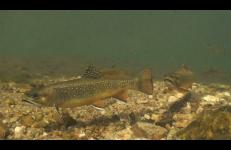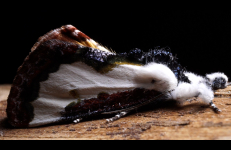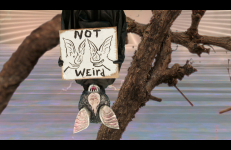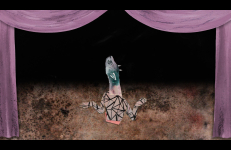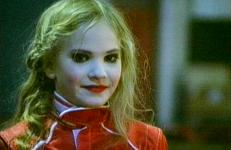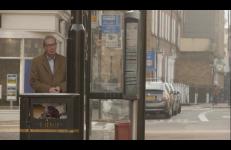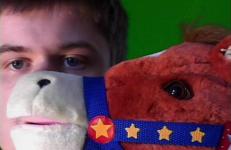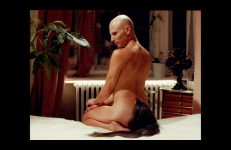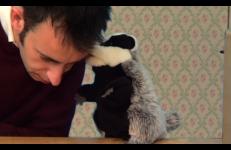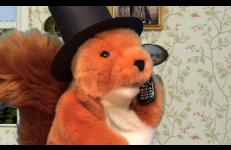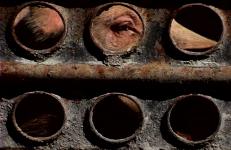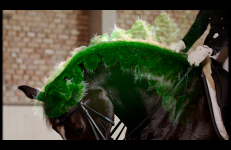The Baroness Elsa von Freytag-Loringhoven né Plotz, was an unsung member of the Dada Movement. A poet, artist, runaway, and all around public provocateur; she actively did not fit into her historical moment, and like most misfits, suffered for it. As with many women artists throughout history, her cultural legacy has been obscured and in some instances appropriated into the oeuvres of better known male peers.
Animals
Videotaped on August 13th 1972, this tape features a number of scenes shot for Lanesville TV, including the Videofreex at the Catskill Game Farm shooting footage of the animals. There are some oddball images… a woman on an exercise machine, and someone in a gorilla suit brushing their teeth. A man named Steve Toomie from Tannersville, NY talks about Mountaintop Youth Group’s performances. There is the horse riding competition in Hunter. A little girl asks, “Are you the Lanesville Television guy?” and then shows her horse ribbon to the camera.
Lesser Apes tells the story of a love affair between a primatologist, Farrah, and a female bonobo ape, Meema. Bonobos are the species with which humans share the most DNA, but unlike our species, they are matriarchal, live without conflict, and are unabashedly sexual. A paean to perversion, the film combines animation, live action and song to challenge attitudes about sex, language and our relationship to nature.
Lesser Apes tells the story of a love affair between a primatologist, Farrah, and a female bonobo ape, Meema. Bonobos are the species with which humans share the most DNA, but unlike our species, they are matriarchal, live without conflict, and are unabashedly sexual. A paean to perversion, the film combines animation, live action and song to challenge attitudes about sex, language and our relationship to nature.
A tapestry of images and sounds. Tango dancing. A conversation about heaven and hell, with illustrations. Horses nuzzle. A woman reclines. Silent soccer. Street entertainers play classical music. Travel is mysterious and sometimes fraught.
I was drawn to the early cave paintings of Lascaux and Altamira for as long as I can remember. One day looking thru some reproductions in an art history book with portable video camera in hand I recorded a still of a Lascaux bull.
Medicine Bundle is about a bundle that was used in my family to heal my Great Great Grandfather from a smallpox epidemic and a life threatening wound from a gatling gun used against him during the Battle Of Cutknife Hill in 1885. The bundle was again used in 1918 when my Grandfather contracted the Spanish Flu as a baby. It was buried in an unmarked grave to protect it from grave robbers, but the spirit within the bundle has continued to protect our family from more modern psychological effects of colonization like depression.
The viewer is whisked through a lovely cat-house, which also includes a turtle along with the whiskered pets, and then is suddenly immersed in the painted output of my old (yet still young and vibrant looking) friend, Michelle Joyce. We follow this cheerful personage on a tour of her studio and then get transported to a high-class arts center in midtown Frisco where the work is displayed to a variety of yapping youth in yo-yo mode.
This video is about two fictional characters, as in letters, and two fictional characters, as in anthropomorphized mice, falling in love. Just as they start their love-dance they are separated by The Hand of language/culture/logic and are forced to learn and embody new signifiers in order to reunite at the end and finish dancing.
"I brought live reptiles, birds of prey and exotic flowers to a very stereotyped and neglected section of the city of St. Louis, Missouri which suffers from from severe abandonment and despair, but also has many tranquil vacant lots where nature flourishes. I chose these birds of prey for their symbolic meaning- The bald eagle a symbol of the United States, hawks and owls are messengers. But this is not a film about St. Louis, It's about an anonymous archetype more than a specific locale. St.
Naked shows a colony of naked mole rats living in a laboratory. This rare and highly socialized species demonstrates modes of behavior that in uncanny ways seem human-like. The mole rats are the most inbred species on the planet, and have the longest life span of any laboratory animal. The film zeroes in on aspects of their existence (overcrowded conditions, violence, tenderness) that have parallels in the life of human society.
Nest-Cams features footage from cameras placed in and around nests. Animals showcased include: black-capped chickadee, red squirrel, house wren, horned lark, red-breasted nuthatch, black tern, brook trout, and song sparrow.
The Night Visitors is a movie about moths. In large and small fragments, looking both inward and out, through a critical lens that is by turns social and personal, the film closely examines these under-known creatures. While The Night Visitors is interested in moths as organisms, with fascinating life histories, staggering biodiversity, and a functional importance as indicators of climate change and habitat degradation, its engagement with them is not primarily entomological.
It’s not the bats’ fault.
Holed up in Lockdown in London during the Covid pandemic, I made a bat-head mask, I made a skeleton.
Now That I've Lost My Buffalo, I Don't Know Who to Grind is a short animation conceived through the collaboration of three visual artists — Diane Christiansen, Jessie Mott, and Alejandra Trigoso — that stages a volatile theater of bodies in flux. Within a shifting frame, cut-out fragments of animals and humans slip in and out of view, forming and unforming as creatures that vomit, expel, and rearrange their own parts. The work resists stable form, instead embracing mutation, rupture, and play as its guiding principles.
Now That I've Lost My Buffalo, I Don't Know Who to Grind is a short animation conceived through the collaboration of three visual artists — Diane Christiansen, Jessie Mott, and Alejandra Trigoso — that stages a volatile theater of bodies in flux. Within a shifting frame, cut-out fragments of animals and humans slip in and out of view, forming and unforming as creatures that vomit, expel, and rearrange their own parts. The work resists stable form, instead embracing mutation, rupture, and play as its guiding principles.
Now That I've Lost My Buffalo, I Don't Know Who to Grind is a short animation conceived through the collaboration of three visual artists — Diane Christiansen, Jessie Mott, and Alejandra Trigoso — that stages a volatile theater of bodies in flux. Within a shifting frame, cut-out fragments of animals and humans slip in and out of view, forming and unforming as creatures that vomit, expel, and rearrange their own parts. The work resists stable form, instead embracing mutation, rupture, and play as its guiding principles.
A simple yet moving story of children and a baby deer set against the background of a go-kart track.
A watchful dog in a confusion of reflected chairs begins and ends Cohen’s finely tuned observational portrait of London’s Essex Street, and the inhabitants who work the shops and throng the pavement there. People hurrying, pausing, waiting or simply standing, intermingled with worn statues of historic peerage in the slanted light of late afternoon. A man holds a copy of The Law of Privacy and the Media as though testing its resilience against the quiet onslaught of an average work day.
Introduces the audience to the rockin' talkin' pony, who provides musical accompaniment for a series of Texas country-dance lessons.
This title is also available on Ben Coonley: Trick Pony Trilogy.
A foley artist creates sounds for a film featuring a dressage horse and dissolves into their own imitation. As the character in the film, played by the gender fluid performer Simon(e) Jaikiriuma Paetau seems to transform into a gender-defying centaur, the film reflects on the boundaries between the human and the animal as well as on fictional gender roles and their transcendence. Shot on 16mm film, Passage alludes to Eadweard Muybridge’s pre-cinematic experiments with horses.
Written, Directed, Produced & Edited: Ann Oren
The Badger Series has issues and attempts, each episode, to resolve them. Recasting a glove puppet show through his own present day sensibilities, Paul assumes the role of kindly uncle mentor to a household of capersome woodland creatures. Mortality, self-sacrfice, depression, altered states of consciousness and transgressive art practices are all explored as part of their everyday lives together.
The Badger Series has issues and attempts, each episode, to resolve them. Recasting a glove puppet show through his own present day sensibilities, Paul assumes the role of kindly uncle mentor to a household of capersome woodland creatures. Mortality, self-sacrifice, depression, altered states of consciousness and transgressive art practices are all explored as part of their everyday lives together.
A close-range look at pigs living on a farm in Las Vegas, Nevada. The pigs, individually and as a group, become a metaphor for humanity as they go from leisurely wallowing in the mud to the wildness of a feeding frenzy. In a key shot, a pig confronts the viewer with a prolonged, enigmatic stare, as if questioning the very nature of human/animal relationship.
“Marvelously abstract and perfectly concrete.”
-- The Jury of the 2011 Hong Kong International Film Festival
A dreamlike journey, a disintegration into a fluid human-animal-plant-machine consciousness, Pirouette follows a sound artist who records horse sounds using her own body, while a cellist on the street invades her imaginary. It is the psychedelic conclusion of the horse-foley trilogy: Passage (2020) - Piaffe (2022) - Pirouette (2024).




